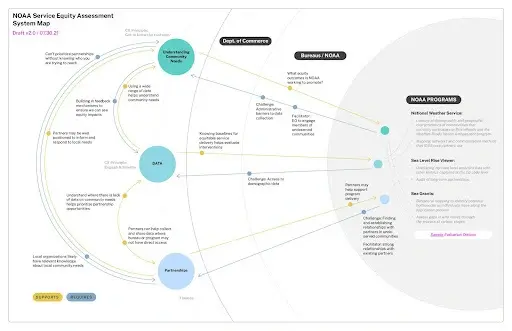Supporting NOAA’s Equity Assessment Teams

Skyline view of city
What was the challenge?
In response to Executive Order 13985, On Advancing Racial Equity and Support for Underserved Communities Through the Federal Government (The Equity EO), Equity Assessment Teams within the National Weather Service, the National Sea Grant College Program, and the Office for Coastal Management conducted service equity assessments for their programs. Their goal was to understand what aspects of their programs perpetuate systemic barriers for members of underserved communities and identify program changes to address these barriers in their upcoming Equity Action Plans.
What did we do?
We partnered with three NOAA Equity Assessment Teams to develop several evaluations that could build evidence about each program’s upcoming Equity Action Plan and NOAA’s efforts to address equity barriers. The recommendations include evaluation approaches based on each program’s service equity objectives, specific definitions of underserved communities, equity baselines and benchmarks, and potential data sources for evaluations.
How are the evaluations designed to build evidence?
National Weather Service
The National Weather Service (NWS) aims to ensure that services offered by Weather Forecast Offices benefit all members of the public and prioritize those that are most vulnerable to loss of life or property as a result of severe weather events. NWS is focused on learning how to define, conduct, and measure effective engagement to better serve historically underserved and socially vulnerable communities. The recommended evaluation approaches are designed to help NWS describe engagement with historically underserved and socially vulnerable communities among Weather Forecast Offices, identify best practices for engagement, and support promising engagement efforts in Weather Forecast Offices across the nation.
Proposed evaluation activities include:
- Mapping current community engagement and outreach events conducted by each Weather Forecast Office to identify any patterns in which communities are currently being engaged and which communities are not.
- Using the resulting community engagement and outreach map to identify Weather Forecast Offices that use best practices to engage with vulnerable communities and identify practices could be applied by additional Weather Forecast Offices.
- Partnering with one or more community organizations to pilot promising engagement strategies.
Office of Coastal Management
The Office for Coastal Management (OCM) has developed the Sea Level Rise Viewer tool (https://coast.noaa.gov/slr/) to help coastal communities understand their risk and vulnerability to hazards and begin to prioritize solutions to enhance their resilience. OCM has identified a need to understand how the Sea Level Rise Viewer can best support equitable outcomes for coastal communities across the United States and U.S. territories. The recommended evaluation approaches can support OCM in developing a clear picture of who is currently using the Sea Level Rise Viewer and which communities are currently being prioritized by current users. They are also designed to highlight opportunities for the Sea Level Rise Viewer to support decision makers in identifying and prioritizing needs of vulnerable communities when taking action to promote resilience in the face of sea level rise.
Proposed evaluation activities include:
- Using web-analytics data and publicly available measures of equity to, 1) understand whether the Sea Level Rise viewer is accessed by members of underserved demographic groups, and, 2) learn to what extent the Sea Level Rise Viewer is currently used to identify risks of sea level rise within vulnerable communities.
- Organizing stakeholder discussions to understand the extent to which the Sea Level Rise Viewer is currently being used to consider the needs of socially vulnerable coastal communities
- Measuring the impact of strategies to increase use of the Sea Level Rise Viewer to prioritize the needs of socially vulnerable coastal communities.
The National Sea Grant College Program
The National Sea Grant College Program supports scientists and researchers whose work contributes to creating and maintaining a healthy coastal environment and economy. The Sea Grant office wants to ensure that their competitive grant and fellowship programs attract and support scientists who reflect the nation as a whole and whose research equitably benefits the nation’s coastal communities. The recommended evaluation approaches are designed to understand barriers in the current outreach and application process for Sea Grant’s national level fellowships (primarily the Knauss Fellowship Program) that may disproportionately affect Black, Indigenous, and People of Color (BIPOC) applicants and identify promising strategies to address these barriers.
Proposed evaluation activities include:
- Using observations, quantitative data, and interviews to create a behavioral map of the application process, with a focus on the experiences of BIPOC students, to characterize barriers in the outreach and application process in the Knauss Fellowship Program.
- Comparing changes in the demographic composition of applicants for fellowship programs that adopt strategies to address application barriers to fellowship programs that did not institute those strategies.
What did we learn?
This collaboration emphasized the value of taking a program-specific approach to understanding opportunities to promote equitable service delivery. A key need for all three programs is to generate a more complete picture of how the programs engage with underserved communities. Yet there is no single way to generate this picture; each program will likely need to rely on multiple approaches to understand and respond to equity needs.
Addressing three overarching themes may support ongoing efforts to improve service equity at NOAA and across the Federal Government.
- Defining “underserved communities”: Developing a sustainable, flexible definition of “underserved communities” can create a common baseline for programs to work from as they identify and seek to address the barriers to equitable service delivery for the range of communities they serve.
- Establishing the meaning of “community engagement”: Developing a working definition of and flexible metrics for community engagement could serve as a starting point for programs to understand their current patterns of engagement and engagement strategies.
- Filling the engagement data gap: Developing a better understanding of engagement with underserved communities requires information about how programs engage with the public and stakeholders. Yet key data, such as demographic data on users or program applicants, is often not available. A challenge for addressing equity needs is identifying appropriate existing data sources and gathering new information when needed.

